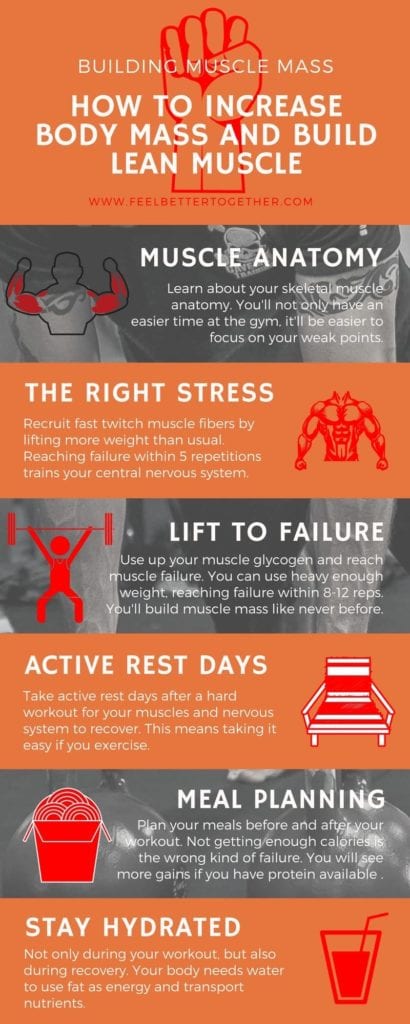Do you want to build a muscular physique? This forum topic benefits the beginner and intermediate, rather than the professional bodybuilder. You may have always been skinnier, and want to fill in your tee shirt a little more.
Or are you trying to lose weight and heard that building muscle mass burns more calories? Have you tried going to the gym but were not sure what to do with all those machines, or which one to use? A lot of us have fundamental questions like how often to go and how much weight we should lift.
It helps to know the basics if you are starting out. To maximize your gains, you need to know what’s going on in your body before, during, and after your visit to the gym. We are going to give you a solid foundation to build muscle mass and the get long-term gains.
Five Things to Focus on When You’re Increasing Body Mass and Building Lean Muscle
- Learn about your skeletal muscle anatomy. You’ll not only have an easier time at the gym; it’ll be easier to focus on your weak points.
- Recruit fast-twitch muscle fibers by lifting more weight than usual. Reaching failure within five repetitions trains your central nervous system.
- Use up your muscle glycogen and reach muscle failure. You can use heavy enough weight, reaching failure within 8-12 reps. You’ll build muscle mass like never before.
- Take active rest days after a hard workout for your muscles and nervous system to recover. Take it easy if you still exercise, and avoid stress if possible. Intense exercise every day is not sustainable for your immune system.
- Plan your meals before and after your workout. Not getting enough calories is the wrong kind of failure. You will also see more gains if you have protein available when you are lifting, and every few hours after that.
BONUS TIP! Stay hydrated during your workout and also during recovery. Your body needs water to use fat as energy and transport nutrients.

Skeletal Muscle Cells – Knowing Your Muscles
Many parts of your muscle tissue all work together to get the job done. Also, it’s difficult to achieve your goals if you don’t know how to use the tools you have.

We’re going to take a closer look at some of these muscle parts, and how they work. So you get a better idea of how muscles grow and adapt as a result of resistance training.
Muscle Fibers
Running alongside your bones and connecting your joints is skeletal muscle tissue. Muscle Fibers attach to a tendon at insertion points in your bones.
The angle that these tendons insert into your bones is a factor in overall strength, which is why people with smaller limbs can display more power relative to their body size.
The muscle fibers in your muscle tissue are not all the same. You have a mixture of fast-twitch and slow-twitch muscle fibers. They work together to allow for bursts of strength (fast-twitch), and energy over time (slow twitch).
Stored Muscle Glycogen
Muscle fibers store up energy, so it’s available whenever the need may arise. Muscle fibers are longer than other cells and have little bits of protein and glycogen.
Your muscle fibers use the stored up glycogen from the food you eat as energy when they contract.
When a muscle cell grows in size, it can store more energy (glycogen). A more prominent muscle is usually a stronger muscle, but not always. Strength is about the speed of muscle fiber contractions, not only how much energy it has stored.
Biologists have studied but not yet proven whether you can grow new muscle fibers. From what we know your body has a fixed amount of muscle fibers, and that number is particular to each person.
Training can enhance the muscle fibers you have, regardless of how many there are. Hypertrophy is the body’s process where cells, including muscle cells, grow in size.
How Your Muscles Respond to Stress When You’re Increasing Muscle Size
Your body is always trying to get into a state called “homeostasis.” It reaches this condition in the absence of threats when it has pretty much everything it needs.

If you need nutrients for normal body functions, you will get hungry. You eat and then you are right again.
Being hungry is a straightforward way of your body telling that you need nutrients. Your muscle can and will adapt as well, and you will need to make a change.
Muscle Fiber Recruitment
Your central nervous system (CNS) takes over when you need to perform a physical action. Your CNS sends electrical signals to your muscle fibers, causing them to contract.
Your CNS doesn’t send electric impulses to all your muscle fibers at once. It recruits only the ones it needs. The difficulty and intensity of a movement are what determines which and how many muscles your nervous system will use.
As a muscle fiber contracts, it uses up some stored energy (glycogen). It immediately begins gathering up more glycogen, but this process takes some time. The muscle fiber also needs to reset before it can contract again. Your CNS recruits other muscle fibers to pick up the load while this muscle fiber is down.
Your CNS will continue recruiting muscle fibers in an alternating fashion until you run out of usable glycogen in all the used muscle fibers. When you are out of stored muscle glycogen, you will struggle to meet strength demands.
Response to Muscle Stress
Like a car out of gas, it feels impossible to keep going. An example is when you are lifting weights and can’t do another repetition.
Fitness experts refer to the lack of stored muscle glycogen as ‘muscle failure.’ Your body sees this as a threat to your survival and will adapt to restore a state of homeostasis.
Your body adapts in two significant ways as a result of the stress related to muscle failure. Exercising builds up pathways between your CNS and the recruited muscle fibers, which allows for more efficient recruitment in the future.
On top of that, your muscle fibers will grow in size to store more glycogen. This process can take as little as two days, but this time varies. The exact time all depends on your lifestyle.
If you are getting enough sleep and all your nutrients, recovery will happen much faster. This healing and adaptation is your body’s way of saying, “I’ll be ready for you next time.”
Muscle Failure Workout – Lifting to Failure
Active military members and paid athletes do not always train to failure. You will have decreased usability of that muscle until healing is complete.

It’s essential that they be able to use their muscles. But when you are looking for muscle gains, it’s necessary that you train to failure. The trick is knowing how and when to fail.
Planning to Fail
Before we get started here, there’s a word of caution. You put too much stress on your joints with lousy form while training to failure. You are putting yourself at risk of injury, and this also applies to movements that are outside your range of motion.
Attempting muscle failure while doing these will guarantee muscle and joint injuries. Nothing kills your muscle gains like a workout injury.
You can reach muscle failure by performing any physical task as long as it puts enough stress on your muscles. Here we’re going to use weightlifting in all our examples. Isolating a particular muscle group is often more natural with weights and the equipment at the gym.
How many repetitions it takes to reach failure depends on how much weight you are using. Using heavier weights and reaching failure in 3-7 reps recruits fast-twitch muscle fibers and is ideal for strength training.
You will still see results, but you are leaving some muscle gains on the table if this is the only way you train. But, if they do not use enough weight and do not reach failure, there will be little or no physical adaptation.
See Gains in Muscle Mass
You’ll see serious gains in muscle mass by training with three sets of 8-12 reps to failure, with 45 seconds between sets. You’ll still see muscle gains if you stay close to this, but you’ll see incredible results using this template. The trick is making sure that you are using enough weight to reach failure by the end of that 12th repetition.
Reaching failure in 12 reps can be hard if you have recently experienced gains using this method. You need more weight to achieve failure at this point.
Progressive overload is the practice of adding enough pressure to cause adaptation. You are progressing in using more weight for each consecutive set or workout, continually overloading your muscle.
You can figure out how much weight to lift for each exercise if you keep track of two things. Let’s say you know that using 50lbs during a particular weightlifting exercise causes failure within 15 reps.
If you want to reach failure within 12 reps, you can try 55 or 60lbs. Keeping track of how much weight, and how many repetitions it takes to get to failure, is all you need to see results.
Do a little warm-up with stretching, some cardio, then use a rep max calculator. Attempt your 4, 5, or 6 rep max and get your numbers from the calculator.
I suggest finding out what your eight-rep max is because it’s not difficult and the lower the number on the chart the more accurate your results are. Adjust the weight from there to reach failure within 8-12 repetitions at any time.
Continuing to See Results
We hope you got a chance to learn about your one-rep max in our topic about building strength. It’s the most you can lift and reach failure after one complete repetition for that exercise.
The amount of weight it takes to reach failure after two repetitions is your called your two-rep max, and so on. It’s dangerous to attempt a one-rep max without help, so most people need an alternative, like the calculator.
If you have seen some gains and now want to increase your weight, take a minute to think about your sets. Using more heavier weights means you will be doing fewer repetitions, say your five rep max.
You’ll be more tired after each set and will find yourself resting an extra minute or so. You may also be able to do more in one workout session because you are doing fewer repetitions per set.
You should include a few of these low rep sets into your workout any time your results slow down. You can train your CNS to recruit more fast twitch fibers, and at the same time. You’ll be able to lift more and reach failure within your desired rep range.
You’ll need to update your numbers in the rep max calculator from time to time, as you experience gains. Update them now if you have seen some results lately.
Also update them if you have been in a calorie deficit, because you may have lost some muscle.
If you work hard and keep track of your workouts, you’ll see your body transform! You will even get a feel for the process, and it will become easier.
Over time your numbers will change less and less as you get closer to your growth potential. Now getting to your highest weight possible is only a matter of recovery and diet.
Muscle Soreness Recovery – Days Off and Healing
Delayed onset muscle soreness (DOMS) peaks at about two days after a workout. You experience DOMS after doing any new or intense exercise, and it can be uncomfortable, especially if you pushed all the way to failure several times.

DOMS is not a good indicator of the recovery time of a muscle. When a muscle adapts, it goes through quite a bit to put you back together again.
Your body takes up to 24 hours of regular eating to replenish stored glycogen. But repairing your muscles requires more than restoring muscle glycogen. Your muscles adapt to threats, and they see the damage as a threat.
Damage Control
Your muscle fibers suffer tiny tears when you put massive amounts of stress on them. Right after your workout, your immune system kicks in and starts healing the damage. It can take between 2-7 days for your immune system to recover from the small tears in all your muscle tissue.
Your body mobilizes resources and a process call anabolism takes place. During this time your body is building up your muscle fibers, by filling in the tears with more cells made from protein. To your body, this is a serious business.
The Risk of Over Training
Lack of sleep is one of the top reasons why people don’t see the kind of muscle gains they were expecting. The recovery part of training is when the muscular development happens, and is also when your body is working the hardest. Trying to keep up with constant intense exercise can become too much for your body to handle.
You can take active rest days to avoid the adverse side effects of overtraining. Take it easy on rest days so that you don’t put stress on your body, giving it time to catch up.
Burning fewer calories on rest days also means that you don’t need to eat as much. Make sure to at least hit your minimum calorie requirements to avoid overtraining.
You’ll develop flu-like symptoms if you overtrain because you are not getting enough rest or nutrients. Your body needs rest as much as, and often more than it needs exercise. Malnutrition isn’t only uncomfortable, it also increases the risk of workout injuries.
What to Eat to Gain Muscle – The Muscle Gain Diet
When you are reaching muscle failure, your body needs more calories because you are using up some the calories it usually gets on repairing muscle. Protein and carbohydrates and used up to heal and restore your muscle tissue.

Consider meal planning to get incredible results if you are struggling with meal time.
Protein Timing
Your cells need extra protein the whole time while your muscles are healing. The problem is that protein does not get stored in the body in the same way that fat does.
If you are running low and need extra protein, your body gets it from other lean muscle. This is not a quick process and shouldn’t make you afraid to skip a meal or two if you are fasting.
But, if your body needs extra protein and isn’t getting it, your muscle gains will suffer. You’ll get the most muscle gains if you eat 20-30 grams of protein every 3-4 hours.
Your body creates new protein to heal your muscle cells, which occurs for 3-4 hours after you eat a protein-rich meal. Eating protein 1 hour before your workout will ensure it is available.
Your body needs protein the most right after your muscle-building workout. Have it handy from having eaten nutritious food or supplementing protein with protein isolate.
Replenishing Carbohydrates
Your muscles used a lot of carbohydrates in the form of glycogen when you lifted all those weights. A calorie surplus is when you are eating more calories than you are burning.
You’ll need to eat more calories now, since lifting weights burns calories.
Starchy carbohydrates are excellent when it comes to muscle building. You can get starchy carbohydrates from pancakes and sweet potatoes. All fruit is higher in simple sugar but is still an excellent source of fiber and sometimes starchy carbs.
The food we already mentioned is nutrient-dense. Let this be your primary focus when selecting protein and carbohydrate sources.
A nutrient-dense protein is a complete protein and contains Lucien, which stimulates protein synthesis. Almost any unprocessed carbohydrate-rich food is a nutrient-dense carbohydrate.
Don’t forget about the fat! But since we’ve mentioned all three of them, let’s try using a daily macros calculator. You may want to count your macronutrients if keeping up your calories is difficult for you.
You can use the calculator to get a sense of your macronutrient counts on a muscle-building eating plan.
In Conclusion
Gaining muscle mass does not have to be out of your reach. Don’t let muscle loss or a plateau get you down. Check your basics.
Make sure you’re doing the essentials, and you will see some serious muscle gains! We all need to have a goal. What’s yours?
Do you want to compete against other athletes in a competitive professional sport? Are you looking to reach your max and stand against the greatest bodybuilders in the world?
Or is it that you want to be able to hold your kids when they get other, and their kids, without joint and muscle pain? No matter what your goal is for muscle gain, go for it! We have your back.

